|
 Secure Site
Secure Site
|
 |
Archive for March, 2012
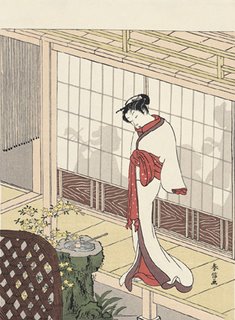 harunobu suzuki, Beauty at the Veranda
You can add vocalization to almost any pose to develop your sound and calm your emotions
You can add vocalization to almost any pose to develop your sound and calm your emotions, says Suzanne Sterling, a yoga teacher and kirtan leader. Using traditional Sanskrit seed sounds like “om” and “ah,” find a comfortable pitch and sing gently on the exhalation as you move through your daily practice. Most beneficial to the voice are poses that release upper-body tension, relax and open the throat, and promote alignment. Here are a few to try:
Simhasana (Lion Pose) is a great way to revitalize and relax all the muscles involved in vocal production. If you vocalize as part of this pose (the lion’s “roar”), keep it gentle and move completely through your vocal range, high to low. Don’t force the sound.
For passively relaxing the throat, seek out poses that tilt the chin toward the chest. “Shoulderstand is a great pose for the throat,” says Ann Dyer, a nada yoga teacher and vocalist based in Oakland, California. If you can’t do Shoulderstand, try Setu Bandha Sarvangasana (Bridge Pose).
For actively opening the throat, you want gentle bends that tilt the head back. Dyer recommends Matsyasana (Fish Pose) and Urdhva Dhanurasana (Upward Bow Pose).
adapted from Yoga Journal by Karin Beuerlein, a writer in Knoxville, Tennessee.
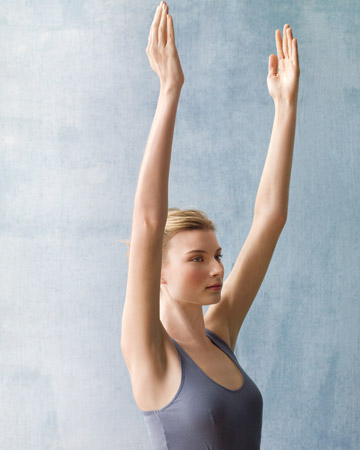 Yoga and Meditation Chime Timers - Elegant and Soothing Using a kitchen timer or beeper watch is less than ideal when practicing yoga. And it was with these considerations in mind that we designed our digital Zen Alarm Clock and Yoga practice timer. This unique “Zen Clock” features a long-resonating acoustic chime that brings the meditation or yoga session to a gradual close, preserving the environment of stillness while also acting as an effective time signal. The Digital Zen Clock can be programmed to chime at the end of the meditation session or periodically throughout the session as a kind of sonic yantra. The beauty and functionality of the Zen Clock/Timer makes it a meditation tool that can actually help you “make time” for meditation yoga in your life.
 meditation timer and clock Now & Zen’s Meditation and Yoga Timer Store
1638 Pearl Street
Boulder, CO 80302
(800) 779-6383
Posted in yoga
 Get Rid of That Beeping Alarm Clock - Kiyonaga Torii, Beauties in September Boulder, Colorado—an innovative company has taken one of life’s most unpleasant experiences (being startled awake by your alarm clock early Monday morning), and transformed it into something to actually look forward to. “The Zen Alarm Clock,” uses soothing acoustic chimes that awaken users gently and gradually, making waking up a real pleasure. Rather than an artificial recorded sound played through a speaker, the Zen Clock features an alloy chime bar similar to a wind chime.
When the clock’s alarm is triggered, its chime produces a long-resonating, beautiful acoustic tone reminiscent of a temple gong. Then, as the ring tone gradually fades away, the clock remains silent until it automatically strikes again three minutes later. The frequency of the chime strikes gradually increase over ten-minutes, eventually striking every five seconds, so they are guaranteed to wake up even the heaviest sleeper. This gentle, ten-minute “progressive awakening” leaves users feeling less groggy, and even helps with dream recall.
One of the ultimate Zen like experiences is waking-up from a great slumber refreshed and energized. Your mind and body are harmoniously one, both alert and focused. Having a refreshed mind and body are two keys to a natural and Zen lifestyle. Waking up in the morning should not be a loud and abrupt awakening, but rather it should be a peaceful positive experience. The right natural alarm clock can transition your deep and tranquil sleep into a serene start to consciousness. Imagine a long-resonating Tibetan bell-like chime waking you up to a beautiful morning experience.
The right alarm clock can be the most beneficial investment for you. With our Now & Zen natural alarm clock you are awakened more gradually and thus more naturally. Now & Zen is focused on creating a naturalistic lifestyle, and our clocks are an example of our philosophy.
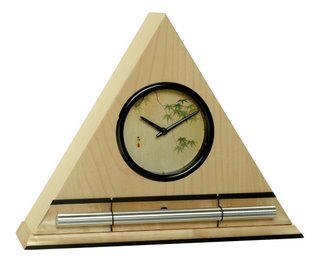 Soothing Chime Alarm Clocks - An Alternative to the Beeping Alarm Clock Now & Zen – The Zen Alarm Clock Store
1638 Pearl Street
Boulder, CO 80302
(800) 779-6383
Posted in Bamboo Chime Clocks, sleep, Sleep Habits, wake up alarm clock
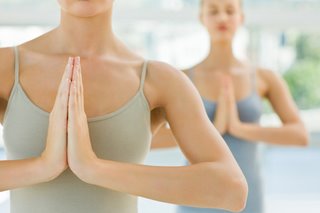 yoga at home I got into yoga as a college student on a typically tight budget. To save money I decided to memorize my favorite sequence and practice at home. It was love at first Sun Salute. But not so much in class, where I obediently followed along, trying my best to keep up with a fast-moving flow, diligently taking the inevitable corrections, and silently cursing the woman next to me who was clearly related to Gumby.
Practicing at home gave me the time and the freedom to play in the poses and see how my body reacted. “You can feel when a pose is right and when it’s a little off,” says Barbara Benagh, a Boston yoga instructor and home practice veteran. “If it doesn’t feel right, it doesn’t matter how good it looks.” My first uncertain, bumbling adjustments eventually guided me to a better understanding of yoga as well as my own strengths, limitations, and needs.
Think of yoga, especially a home practice, as a learning process. There will be fits and starts, but you’re not alone in your struggle for consistency. “Sometimes the challenge is doing it at all,” admits Benagh. But once you step on the mat, you can let the practice take shape. Whether you stick to a specific sequence or just muddle through a few of your favorite poses, you’re still doing yoga. Give yourself permission to explore the poses that attract you and, just as importantly, those that you resist. Tune into how your breath feels, where your mind goes, and the sensations that each pose invites. Avail yourself of books, DVDs, and websites (see “At-home helpers” on page 58 for suggestions), and go at your own pace. Once in a while get a yoga checkup by going to a class that emphasizes adjustments or splurging on a yoga private session.
 yoga at home, use a yoga timer tool from Now & Zen The bonuses of a steady practice may surprise you—improvements in your health, strength, flexibility, and general quality of life. A new study published in the Journal of Alternative and Complementary Medicine reports that just one week of daily yoga practice increases spinal flexibility and decreases pain in people suffering from chronic low back pain. Plus you’ll strengthen your body’s ability to fight disease: A 2007 study analyzing antioxidant levels in the blood found that study participants who had practiced yoga for six months had significantly higher levels of free radical–fighting antioxidants in their blood than the control group.
My home practice was born of financial limitation, but I’ve stuck with it for many different reasons: self-nurturing when I’m feeling down or during that-time-of-the-month, a busy schedule, convenience, a chance to work on difficult poses in the privacy of my own home (with no Gumbies around). Whatever inspires you to begin a home practice, this easy-to-follow guide can help you succeed.
The yoga of distraction
You don’t need a private studio to have a successful home practice. But it does help to create a space you can come back to where you feel comfortable and focused. Distracted by a cluttered room? Take five minutes to tidy up before stepping on the mat; it can be a great way to center yourself for each session. Have trouble staying put? Benagh suggests you use music—just practice for the length of one album or playlist—to provide some structure as well as motivation to stick it out. But she reminds us that, “one element of yoga is discipline and exertion. Be patient with the process, and you will build stamina by continuing to persevere even when you get discouraged.”
 Kid Yoga Lotus Pose Focus on the breath
Yoga’s mindful breathing sets it apart from most other forms of exercise. This diaphragmatic or belly breathing begins in the abdomen rather than the chest, pulling the air deeper into the lungs, which fosters more complete oxygen–carbon dioxide exchange. To tune in to your breath, sit comfortably, and rest your hand on your belly. As you inhale, feel your belly filling up with breath; as you exhale, allow your belly to empty.
By linking your inhale and exhale to your movements, you can use the breath as a powerful guide for your yoga practice. Pay attention to the quality of the breath. If it feels jagged, you may be working too hard. Ease up or go into Child’s Pose until you feel ready to move again. If your breath becomes very slow or lazy, you may be losing focus. Challenge yourself to stay more alert and active in your practice. If at any point you lose track of your breathing, that’s OK. Just notice it, and come back.
Build a sequence
A balanced sequence of poses moves your body and spine through its full range of motion—circulating oxygen-rich blood, eliminating toxins, stretching and lubricating the entire body. Every asana (body) falls into at least one, and sometimes several, of eight categories—standing, balancing, forward bends, backbends, hip openers, twists, inversions and restoratives. Each type offers different benefits, challenges, and insights.
Standing postures ground your energy, revitalize the legs, improve balance and digestion, build bone density, and lubricate joints. * Balancing postures improve balance, build bone density, focus the mind, and strengthen the joints. * Backbends open the chest and heart, relieve depression, keep the spine supple, and energize body and mind. * Forward bends soothe the nervous system, release tension in the back, and promote sound sleep. * Hip openers promote pelvic, prostate, and reproductive health and reduce sciatic pain. * Twists lubricate the spine and tone and detoxify the organs. * Inversions tone and relax the organs, recirculate blood, center the mind, and improve concentration. * Restorative postures do exactly that: Restore mind and body and reduce stress and tension.
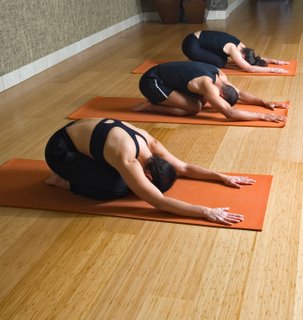 yoga practice The four Bs
* Blocks help you maintain proper alignment while you build strength and flexibility. * A belt supports you in restorative poses and helps you stay aligned and safe as you stretch. * A bolster supports your body in passive, restorative poses. * A blanket can be used in lieu of or in addition to a bolster to make you more comfortable and help you relax.
Now you’re ready to go. Try the following sequence, courtesy of yogis Rodney Yee and Colleen Saidman, creators of the Gaiam Yoga Club, an online community offering healthy home practices anyone can do.
1. Mountain Pose
(Tadasana)
How to: Stand with your feet parallel, heels slightly apart, and big toes touching. Broaden your collarbones, press your shoulder blades into the back to open up your chest, and place your arms by your sides. Lengthen through the sides of your waist, and balance your head over your shoulders, feeling a sense of ease (and no tension) in the neck. Breathe here for eight to 10 breaths.
standing pose
2. Tree Pose (Vrksasana)
How to: From Mountain Pose, bring your right foot up and press it against the inside of your left thigh or calf, or rest your right heel on the inside of your left ankle. Keep your hips facing the front and your right knee opening out to the side. Stay here for five to eight breaths; release your right leg to the floor and return to Mountain Pose. Repeat pose on the other side.
Variation: Hold on to the back of a chair or touch the wall for balance if you need to. Caution: Don’t rest your foot against your knee as this can cause strain in the joint.
standing; balance; hip opener
3. Standing Forward Bend
(Uttanasana)
How to: From Mountain Pose, exhale and fold from the hips (not the waist), and bring your hands to the floor beside your feet. Keep your knees lifted, relax the low back, and soften the belly. Stay here for five to eight breaths.
Variation: Rest your hands on blocks if they don’t reach the floor; bend your knees to avoid stress on your lower back. Caution: If you have sciatica, you may want to avoid this posture.
standing; forward bend; inversion
4. Downward-Facing Dog Pose (Adho Mukha Svanasana)
How to: From Standing Forward Bend, step your feet back, coming into a plank position (yoga push-up position—arms straight, shoulders over hands, and legs straight so that your body forms a flat plank). Exhale and lift your sit bones toward the ceiling, pressing into your palms and inner arms. Keep the kneecaps lifted; reach your heels toward the floor. Stay here for five to eight breaths, and work up to 15 breaths. Step your right foot between your hands, then your left foot, returning to Mountain Pose.
Variation: Rest your forehead on a block (to ease a headache, calm your nerves, or cool a hot flash).
standing; inversion
5. Triangle Pose (Trikonasana)
How to: From Mountain Pose, step your feet about 3 to 4 feet apart. Turn your left foot slightly inward and your right foot out 90 degrees; the heel of your right foot should be in line with the heel of your left. Stretch your arms out to the sides, lift up through the front of your thighs, and press your shoulder blades into your back to open your chest. Exhale, and keeping both sides of your waist long, extend your trunk to the right and bring your right hand down to your shin or a block. Stretch your left arm up to the ceiling. Look straight ahead or up at your left hand. Rotate your belly toward the ceiling. Hold for five to eight breaths. On an inhalation, lift up and turn your feet back to a parallel position. Repeat on your left side, then turn your toes forward and step back into Mountain Pose. Note: The object is to support and open the chest by keeping your spine and waist long. Don’t worry about bringing your hand all the way down to the floor.
Variation: Place a block on the outer edge of your right foot to support your hand.
standing; hip opener; twist
6. Extended Side Angle Pose
(Utthita Parsvakonasana)
How to: From Mountain Pose, step your feet out slightly wider than you did for Triangle Pose. Turn your right foot out 90 degrees and your left foot slightly inward. The heel of your left foot should line up with the heel of your right. Stretch your arms out to the sides, exhale, and bend your right knee so that your thigh is parallel to the floor. On your next exhale, extend your trunk to the right, keeping both sides of your waist long, and bring your right hand down to a block (or rest your elbow on your thigh). Stretch your left arm up over your left ear, rotate your belly toward the ceiling, and look up under your armpit. Breathe and hold this pose for five to eight breaths. Inhale as you lift up, and straighten your torso. Repeat on the left side and then step back into Mountain Pose.
Caution: Don’t do this pose if you have arthritis of the knee or very low blood pressure.
standing; hip opener; twist
7. Cobra Pose (Bhujangasana)
How to: Lie flat on your stomach, forehead on the floor. Bring your hands beside your chest so that your forearms are perpendicular to the floor and your elbows are tucked in to your sides. Inhale, lift up from your chest, elongating your waist and spreading your collarbones wide. (You should not feel a pinch in your lower back in this gentle backbend). Keep your legs active and pelvis on the mat. Hold for five to eight breaths. On an exhalation, release back into the floor, turn your head to the side and rest for a moment before repeating.
Caution: Do not do this pose if you are more than three months pregnant.
backbend
8. Bound Angle Pose (Baddha Konasana)
How to: Sit with your back straight and your belly lifted. Bend your legs, and bring the soles of your feet together in front of you, allowing your knees to open out to the side. Hold your ankles, and draw your heels toward your pubic bone. Gently lower your knees as far as possible. Put your hands on the floor behind you to sit up taller and encourage the natural curves of the spine. Stay here for eight to 10 breaths.
Variation: Sit with hips on a folded blanket or a bolster and feet on the floor if your knees come up higher than your waist. Place a block under each thigh.
hip opener 9. Simple Seated Twist Pose
(Parivrtta Sukhasana)
How to: Sit cross-legged on the mat. Lengthen through the sides of your waist and elongate your spine. Place you left hand on your right knee and bring your right hand to the floor behind you. Keeping your hips facing straight ahead, begin twisting to the right from your belly first, then your ribcage, chest, and shoulders. Look over your right shoulder. Stay here for five to eight breaths. Come back to the front and repeat on the other side.
Variation: Place a block behind you to support your hand; sit up on a folded blanket with your knees and feet on the floor.
Caution: Avoid this pose if you have a cold or congestion in your chest.
twist
10. One-Legged Forward Bend (Janu Sirsasana)
How to: With your legs stretched out in front of you, bend your left knee and place your left foot on the inside of your right leg, near your groin. Keeping the right leg straight, turn your abdomen and chest so your sternum is in line with the center of your right leg. Inhale and stretch up. Exhale as you reach your arms out in front of you, and fold your trunk forward over your right leg. Stay here for at least eight breaths or longer if you like.
Variation: If you have tight hamstrings, wrap a belt around the base of your right foot and hold onto it as you fold forward. For a more restorative pose, put a bolster on your outstretched leg and rest your head and arms on the bolster.
Caution: Don’t do this pose if you have sciatica.
forward bend; twist
11. Corpse Pose (Savasana)
How to: Lie on your back with your legs stretched out in front of you. Rest your arms at your sides, slightly away from your torso, palms facing up. Actively stretch your arms and legs away from you, then allow them to release completely. Close your eyes, and let everything relax. Let your breathing become natural and effortless. Rest here for five to 10 minutes.
Variations: Place a folded blanket or bolster under you knees to release the back muscles. Cover up with a blanket if you feel cold. You can also use an eye pillow to help the eyes and brain relax.
Use our unique “Zen Clock” which functions as a Yoga Timer. It features a long-resonating acoustic chime that brings your meditation or yoga session to a gradual close, preserving the environment of stillness while also acting as an effective time signal. Our Yoga Timer & Clock can be programmed to chime at the end of the meditation or yoga session or periodically throughout the session as a kind of sonic yantra. The beauty and functionality of the Zen Clock/Timer makes it a meditation tool that can actually help you “make time” for meditation in your life. Bring yourself back to balance.
Adapted from Natural Solutions Magazine, August 2008, by Nora Simmons
 Bamboo Zen Chime Clocks & Yoga Timers Now & Zen – The Yoga Timer Store
1638 Pearl Street
Boulder, CO 80302
(800) 779-6383
Posted in Bamboo Chime Clocks, Chime Alarm Clocks, Now & Zen Alarm Clocks, Yoga Timer, Yoga Timers by Now & Zen
 Staying Healthy - woodblock print by Toyohara Chikanobu (1838-1912), dated 1896; In the midst of the cold winter months, a burst of sunshine is a welcome sight. When most days are gray, it’s hard to remember that the sun is still there in the sky—it hardly pierces through the gray curtain of clouds that seems to seal in cold air. The apparent absence of sunlight can drive even the most chipper of people into a mental funk.
One reason why the winter months can be so hard is due to the inability of the body to attain and process vitamin D, which is responsible for keeping autoimmune diseases, seasonal affective disorder, poor bone health, and arthritis at bay. The sun is the body’s single most reliable source of vitamin D, and between the months of November and April, there are no ultra-violet B rays available north of Atlanta, Georgia. This causes vitamin D levels to drop drastically.
Vitamin D boosts the immune system, thus explaining why the common cold and influenza make a widespread appearance this time of year. Sunlight is also known to decrease stress and anxiety, not necessarily because of its affect on vitamin D levels, but because of its general mood-boosting properties; serotonin production increases in sunlight.
So how do you make sure you get enough sunlight in winter? Get outside for at least 30 minutes a day even if you’re bundled up like an Arctic explorer. If 30 minutes isn’t an option due to a packed schedule, a light therapy lamp with 10,000 lux simulates daylight and tricks your mind into reaping the mental benefits of sunlight. If you’re feeling fine in your mind but can’t get rid of a cold, Vitamin D can be found in cod liver, fish oil, herring, oysters, salmon, halibut, soymilk, shrimp, milk, fortified cereals, mushrooms, and eggs. Northerners will want to explore a vitamin D supplement.
In the dead of winter, it may be hard to imagine the warm, summery days that will eventually return, but they will. In the meantime, load up on vitamin D, bundle up, and keep moving!
adapted from Natural Solutions Magazine, February 2012
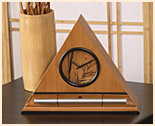 Zen Alarm Clocks and Timers for Yoga and Meditation Now & Zen – The Zen Alarm Clock Store
1638 Pearl St.
Boulder, CO 80302
(800) 779-6383
Posted in Meditation Timers, mindfulness practice, Natural Awakening, nature
 How to get that Elusive Good Night's Sleep - Tsukyoka Yoshitoshi 1888 Stanford’s Dr. Clete Kushida, president of the American Academy of Sleep Medicine, who has worked in the field of sleep research since 1977, offers these tips to a better night’s sleep:
Maintain a regular schedule, getting to bed and rising at the same time as consistently as possible each day, selecting the number of hours of sleep that make you feel best, whether it’s seven hours or 10.
Use bright light within five minutes of waking, for 30 minutes, to synchronize your internal clock.
Avoid bright light two to three hours before bedtime, which delays sleep onset. If you read, get just enough light to read and avoid halogen.
Avoid remaining in bed if you can’t sleep. After 20 minutes, if you can’t sleep or fall back asleep, go into another room and do something else until you feel drowsy.
Avoid reading or watching TV in bed (especially thriller novels or action shows) unless it makes you drowsy.
Avoid napping, unless you nap every day at the same time for the same amount of time or you are tired and about to get behind the wheel of a car.
One of the ultimate Zen like experiences is waking-up from a great slumber refreshed and energized. Your mind and body are harmoniously one, both alert and focused. Having a refreshed mind and body are two keys to a natural and Zen lifestyle. Waking up in the morning should not be a loud and abrupt awakening, but rather it should be a peaceful positive experience. The right natural alarm clock can transition your deep and tranquil sleep into a serene start to consciousness. Imagine a long-resonating Tibetan bell-like chime waking you up to a beautiful morning experience.
The right alarm clock can be the most beneficial investment for you. With our Now & Zen natural alarm clock you are awakened more gradually and thus more naturally. Now & Zen is focused on creating a naturalistic lifestyle, and our clocks are an example of our philosophy.
adapted from SFgate.com
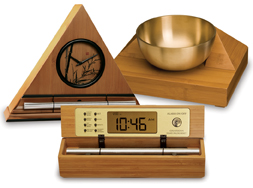 Waking up in the morning should be as pleasant as falling asleep at night. The Zen Alarm Clock's gradual, gentle awakening is transformative. Now & Zen’s Gradual Chime Alarm Clock Store
1638 Pearl Street
Boulder, CO 80302
(800) 779-6383
Posted in Chime Alarm Clocks, sleep, Sleep Habits, Zen Alarm Clock, Zen Timers
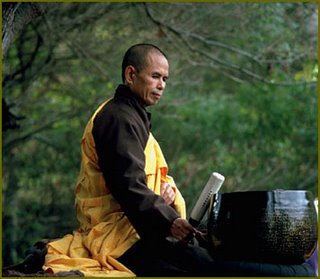 Compassionate Listening Practice by Thich Nhat Hanh When we speak of listening with compassion, we usually think of listening to someone else. But we must also listen to the wounded child inside of us. The wounded child in us is here in the present moment. And we can heal him or her right now.
Practice:
“My dear little wounded child, I’m here for you, ready to listen to you. Please tell me all your suffering, all your pain. I am here, really listening.” If you know how to go back to her, to him, and listen like that every day for five or 10 minutes, healing will take place. … Do that for a few weeks or a few months, the wounded child in you will be healed. Mindfulness is the energy that can help us do this. —Thich Nhat Hanh, from Anger: Wisdom to Cool the Flames
Our Zen Timepiece’s acoustic 6-inch brass bowl-gong clock is the world’s ultimate alarm clock, practice timer, and “mindfulness bell.”
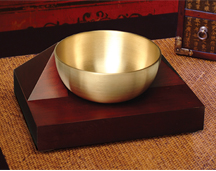 Singing Bowl Mindfulness Gong and Timer adapted from Natural Solutions Magazine, January 2008
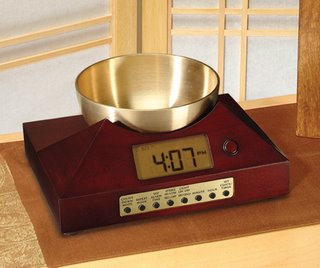 Zen Timepiece with brass bowl, a perfect meditation timer with gentle gong Now & Zen’s Clocks and
Timers
1638 Pearl Street
Boulder, CO 80302
(800) 779-6383
Posted in intention, Meditation Timers, Meditation Tools, mindfulness practice, Natural Awakening, prayer, Well-being, zen, zen monks, Zen Timers
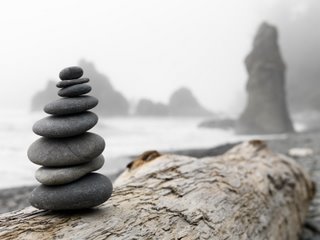 zen-like experience -- waking gently with soothing chimes One of the ultimate Zen like experiences is waking-up from a great slumber refreshed and energized. Your mind and body are harmoniously one, both alert and focused. Having a refreshed mind and body are two keys to a natural and Zen lifestyle. Waking up in the morning should not be a loud and abrupt awakening, but rather it should be a peaceful positive experience. The right natural alarm clock can transition your deep and tranquil sleep into a serene start to consciousness. Imagine a long-resonating Tibetan bell-like chime waking you up to a beautiful morning experience.
The right alarm clock can be the most beneficial investment for you. With our Now & Zen natural alarm clock you are awakened more gradually and thus more naturally. Now & Zen is focused on creating a naturalistic lifestyle, and our clocks are an example of our philosophy.
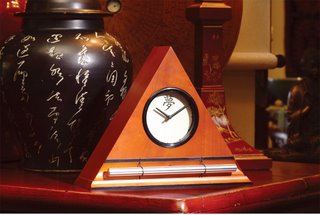 Zen Alarm Clock with Gradual, Soothing Chimes Now & Zen – The Zen Alarm Clock & Meditation Timer Store
1638 Pearl Street
Boulder, CO 80302
(800) 779-6383
Posted in Bamboo Chime Clocks, Chime Alarm Clocks
 tea for stress By Melaina Juntti
When the going gets tough, the tough get brewing, a notion legions of tea-loving Brits have subscribed to for centuries. Now, a City University of London study shows that putting a kettle on the stove and sipping tea in times of crisis or unrest can reduce stress—and even make you feel calmer than before the trauma. After subjects completed timed, stress-inducing tests, researchers gave one group half a cup of English breakfast tea and the other group water. While the water drinkers’ anxiety shot up 25 percent in response to the quiz, the tea sippers’ stress decreased 4 percent from pre-test levels. But the scientists don’t attribute these results to tea’s soothing compounds—such as the anxiety-easing amino acid L-theanine—they believe the ritual’s comforting, cultural familiarity soothes rattled minds. Plus, because Brits are so accustomed to reaching for tea, many associate warm cupfuls with calming situations such as a caring mum putting on a kettle. So next time you’ve sparred with your sister or spent hours in traffic, channel the Brits and brew up a cup.
“The Zen Alarm Clock & Chime Timer’, uses soothing acoustic chimes that signal it’s time – gently and gradually.
Rather than an artificial recorded sound played through a speaker, the Zen Clock features an alloy chime bar similar to a wind chime. When the clock’s alarm is triggered, its chime produces a long-resonating, beautiful acoustic tone reminiscent of a temple gong.
 Chime timer and alarm clocks Now & Zen – The Zen Alarm Clock & Timer Store
1638 Pearl Street
Boulder, CO 80302
(800) 779-6383
Posted in Well-being
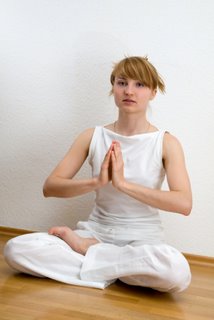 yoga when you are tired, yoga when you are wired... After a stressful day, yoga brings your body and
mind back into balance.
By Karen Macklin
We’ve all been there at the end of a long day: too exhausted to do anything substantial but too hyped up and jittery to really relax. Feeling simultaneously tired and wired happens more often than many of us would like, and it can be hard to know what kind of practice is best to do when you feel this way.
“The goal of yoga, among other things, is unification of body and mind,” says Frank Jude Boccio, a yoga and meditation teacher. But when your body is tired and your mind is wired, he says, you don’t experience that unification. “The beauty of it is that yoga practices are specifically designed to bring the two into balance.”
According to Boccio, the first step is to rest the body. Even if your job is not physically rigorous, he says, your body is tired at the end of the day because the mind uses a lot of glucose, which leaves you feeling depleted.
Boccio recommends this short series of restorative postures that combines forward folds to calm the nervous system and simple twists to revitalize the body and move stagnant blood, rebalancing your energy.
Once your body starts to relax, Boccio says, you can bring your mind into balance with it by doing a simple breath-awareness practice. Start by exhaling completely, with long and steady breaths, as if the receding waves are drawing with them the accumulated detritus of the day; then take deep inhalations that feel like waves coming in with great force. Finally, beware of how much you reactivate the mind with television or computer time before going to bed. If you don’t get enough sleep, you start the day feeling depleted, and end it feeling even more so.
To unwind just before going to sleep, Boccio suggests giving yourself a foot massage: Coat the sole of your foot with raw sesame oil (you can add a few drops of a calming essential
oil like lavender), and massage for a few minutes. This brings the energy down in the body, helping you feel grounded
before bed.
Begin by feeling the support of the earth
beneath you. Mentally scan your body and
notice your level of fatigue or over stimulation. As you move through the following sequence, hold each pose as long as feels right to you.
Apanasana(Knees-to-Chest Pose)
Bring one knee into your chest, keeping the other leg straight on
the ground. Switch knees, and then bring both knees into your chest. This pose helps release the kidney area, where fatigue is often felt.
Jathara Parivartanasana (Revolved Abdomen Pose)
Extend your arms. Bring your knees over to your right side and hold; switch sides.
Twists like these lift your
energy and bring new
blood to your
internal organs
and kidney area.
This calming inversion takes pressure off the lower part of your body.
Come into the pose and hold;
then switch sides. This forward bend helps calm the nervous system.
Seated Twist
Take a gentle twist to either side to help lift lethargy and increase energy.
Use our unique “Zen Clock” which functions as a Yoga Timer. It features a long-resonating acoustic chime that brings your meditation or yoga session to a gradual close, preserving the environment of stillness while also acting as an effective time signal. Our Yoga Timer & Clock can be programmed to chime at the end of the meditation or yoga session or periodically throughout the session as a kind of sonic yantra. The beauty and functionality of the Zen Clock/Timer makes it a meditation tool that can actually help you “make time” for meditation in your life. Bring yourself back to balance.
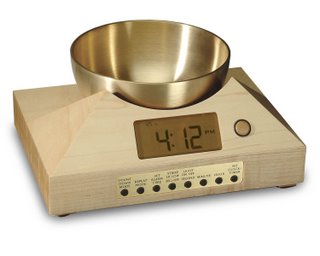 Zen Timepiece by Now & Zen Now & Zen’s Yoga Timer and Alarm Clock Shop
1638 Pearl St.
Boulder, CO 80302
(800) 779-6383
Adapted from Yoga Journal.com
Posted in Chime Alarm Clocks, yoga, Yoga Timer, Yoga Timers by Now & Zen
 Two Women Walking, Shunshô Katsukawa, Ukiyo-e Meditation: It’s all about sitting still, inside a room, going inward. Right? Well, not necessarily. Buddhist tradition has long incorporated a more active technique known as walking meditation. Popularized in the West by Vietnamese monk Thich Nhat Hanh and other teachers, walking meditation often crops up at meditation retreats as a periodic break from long sessions of sitting.
For me—especially on a fine summer morning—a contemplative barefoot circuit of my dewy backyard can sound a whole lot more enticing than hunkering down on a cushion inside. And I seem not to be alone. Across the country, it’s getting easier to find opportunities to meditate in action. Dude ranches, sea kayaking outfitters, and wellness retreats now offer programs that combine basic mindfulness practice with everything from backpacking and rock climbing to horseback riding and paddling.
And why not? A growing body of scientific research supports meditation’s physiological and psychological benefits, including boosting the immune system, helping lower blood pressure, and reducing stress, anxiety, and depression. “Taking mindfulness outside, into the natural world, is another way of connecting the dots,” says Kurt Hoelting, who leads contemplative sea kayaking trips in Alaska. “It helps make it apparent not just intellectually, but also in our bodies, that this process of engagement with the present moment is an avenue to healing and deep restoration.”
Barefoot hiking
Sometimes, freeing your feet can be a revolutionary act. For walking meditation, Thich Nhat Hanh recommends ditching footwear. “You can feel the floor and connect with the earth more easily without shoes,” he writes in Walking Meditation (Sounds True, 2006). “The flow between you and Mother Earth becomes stronger. The longer you practice walking with this connection, the more your heart will be softened and opened, and the more you will feel nurtured, solid, and taken care of by the earth.”
 ume tree (japanese blum) Kaisan-do of Ryodaishi temple Most “barefooters” don’t meditate in any sort of deliberate way, and chances are, they’ve never heard of Thich Nhat Hanh. But his words certainly would resonate clearly. “Going barefoot makes you feel more connected with nature, that you’re part of a bigger universe,” says Jim Guttmann, a member of Barefoot Hikers of Minnesota, an informal group that gathers for regular boot-free rambles.
Like any meditation technique worth its salt, mindful walking begins with a focus on the breath. Breathing in and out with awareness brings the mind home to the body. Practice twice a day, for as few as 10 breaths initially. Breathe normally, sit straight but relaxed, a half-smile on your lips.
Now start walking slowly. Walk around the perimeter of your largest room, or choose a quiet, scenic spot outside. To establish a steady rhythm, try counting steps and using words. If you take three steps for each in-breath, for example, you can say silently, “Lotus flower blooms.” And visualize flowers blooming under your feet. The main thing is to have no goal of arriving; just enjoy each step.
 stillness practice: walking meditation in nature For some, these activities are a way to explore mindfulness through a pastime they already know and love. Others have established a meditation practice but want to broaden their experience. For just about anyone, these “conscious” outings are a great way to slow down, savor silence (which helps increase awareness of what’s really going on, both inside and out), and reconnect with nature—along with one’s own mind, body, and spirit.
excerpted from Natural Solutions, July 2007 (Adapted from Walking Meditation (Sounds True, 2006) by Nguyen Anh-Huong and Thich Nhat Hanh)
Use our unique “Zen Clock” which functions as a Yoga & Meditation Timer. It features a long-resonating acoustic chime that brings your meditation or yoga session to a gradual close, preserving the environment of stillness while also acting as an effective time signal. Our Yoga Timer & Clock can be programmed to chime at the end of the meditation or yoga session or periodically throughout the session as a kind of sonic yantra. The beauty and functionality of the Zen Clock/Timer makes it a meditation tool that can actually help you “make time” for meditation in your life. Bring yourself back to balance.
 Bamboo Zen Chime Clocks & Timers Now & Zen – The Meditation Timer Store
1638 Pearl Street
Boulder, CO 80302
Posted in Chime Alarm Clocks, Japanese Inspired Zen Clocks, Meditation Timers, Meditation Tools, mindfulness practice, zen monks, Zen Timers
« Previous Page — « Previous Entries
Next Entries » — Next Page »
|
|
|
|